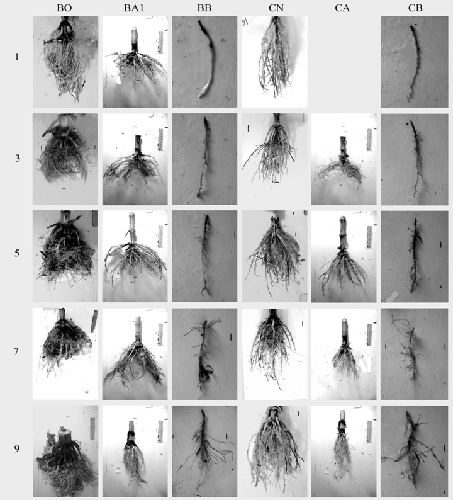The Roots Lab has pioneered the study of root system architecture as a conglomerate of root phenes in both maize and common bean.

Root System Architecture Variations
Root system architecture is a fundamental aspect of plant productivity, particularly in environments characterized by low or strongly stratified water and nutrient availability. Root architecture is composed of a collection of root phones, which determine the temporal and spatial distribution of roots in the heterogeneous matrix of the soil and thus the ability of plant roots to obtain mobile and immobile resources. Agriculture, in many areas of the world, is limited by the availability of water and nutrients. Understanding the role of root phenes will enable more efficient resource capture by roots under conditions of limited water and nutrient availability.
Root phenes and phene states that increase the exploration of deep soil domains enhance the acquisition of mobile nutrients, including nitrate and water, in many environments. These mobile resources are available in deep soil domains over the growing season due to leaching and soil drying from the surface. In contrast, the availability of immobile resources, including phosphate and potassium, is typically greatest in shallow soil domains.
Historically, studies on root traits have been limited due to the challenges of excavating root systems for phenotyping. However, root system architecture including branching, number, diameter, and angles of roots in various root classes has a large impact on plant growth and is observable using Shovelomics. For example, the number of roots in a particular root class and lateral root branching density and length directly influence plant performance under low nitrogen conditions.
Our goal is to identify root architecture phenes and phene synergisms that improve plant growth, particularly in edaphic stress conditions. We aim to understand the functional implications of root phenes on plant growth as well as their genetic architecture.
Digital Imaging of Root Traits (DIRT) software was developed in collaboration with our laboratory (Bucksch et al 2014). This software is an automatic, high throughput computing platform that enables the quantification of root architectural traits from digital photographs. Through the DIRT software and other phenotyping methods, we have identified root architecture phenes that improve plant growth in edaphic stress tolerance and are examining phene synergisms for improved plant performance.

